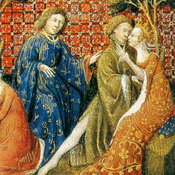
Originally from the word meaning a tale written in the vernacular, as a genre romances incorporate key aspects of medieval culture, including courtly behavior, questing, magic, and, of course, love & devotion. In honor of Valentine's Day, we will explore the writing style of the medieval romance, and dive headfirst into some of the most enduring romance tales--Arthur & Guinevere, Tristan & Isolde, Pyramus & Thisbe, and more! Join us as we untangle the adventures of these star-cross'd lovers to get at the heart of medieval romance!